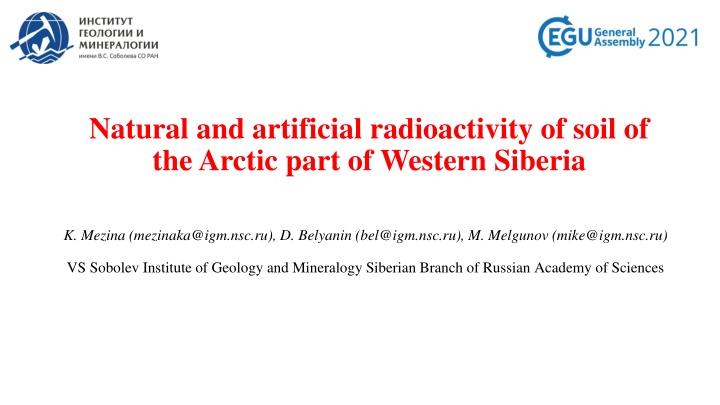
Radioactivity and Mineral Composition of Arctic Soil in Western Siberia
Explore the radioactivity and mineral composition of Arctic soil in Western Siberia through the study of underlying soils, main rock-forming minerals, and radioactive elements. The research aims to understand the radioactivity of terrestrial ecosystems and determine dose loads from radioactive elements on mosses and lichens. The composition of the soils and main minerals were analyzed, revealing correlations between mineral compositions and radioactivity. Sedimentary rocks with low radioactivity content characterize the studied soils.
Download Presentation

Please find below an Image/Link to download the presentation.
The content on the website is provided AS IS for your information and personal use only. It may not be sold, licensed, or shared on other websites without obtaining consent from the author. If you encounter any issues during the download, it is possible that the publisher has removed the file from their server.
You are allowed to download the files provided on this website for personal or commercial use, subject to the condition that they are used lawfully. All files are the property of their respective owners.
The content on the website is provided AS IS for your information and personal use only. It may not be sold, licensed, or shared on other websites without obtaining consent from the author.
E N D
Presentation Transcript
Natural and artificial radioactivity of soil of the Arctic part of Western Siberia K. Mezina (mezinaka@igm.nsc.ru), D. Belyanin (bel@igm.nsc.ru), M. Melgunov (mike@igm.nsc.ru) VS Sobolev Institute of Geology and Mineralogy Siberian Branch of Russian Academy of Sciences
The relevance of research Scientific tasks: To study of the radioactivity of terrestrial ecosystems in the form of mosses and lichens; To determine of the dose load from radioactive elements on these systems. The aim of this work is to study the radioactivity of the underlying soils of theArctic part of Western Siberia. Stages of work: 1. To determine the mineral composition of the soil; 2. To identify the main rock-forming minerals of the underlying soil; 3. To study the radioactive composition of the underlying soils.
Main rock-forming minerals, mineral and particle size distribution Quartz (%) 25-40 40-75 75-90 Potassium feldspa (%) 15-30 5-20 5 Clay minerals (%) 15-30 5-20 5-10 Diameter of particles, m Fraction 1 2 3 Medium silt oarse silt Very fine sand Fine sand Medium sand 15,6-31 31-63 63-125 SiO2TiO2Al2O3Fe2O3Na2O K2O 125-250 1 73 1,0 11,4 3,9 1,7 2,0 250-500 2 85 0,6 5,4 1,7 0,7 1,3 3 96 0,2 1,4 0,4 0,2 0,5
Main rock-forming minerals and radioactive composition SiO2TiO2Al2O3Fe2O3Na2O K2O 1 73 1,0 11,4 3,9 1,7 2,0 2 85 0,6 5,4 1,7 0,7 1,3 3 96 0,2 1,4 0,4 0,2 0,5
Conclusion The radioactive composition of the underlying soils of the Arctic part of Western Siberia , as well as the mineral and granulometric composition, the main rock-forming minerals of these soils were determined. According to the mineral composition and the main rock-forming minerals of the studied soils, three groups of samples were distinguished. These groups are well correlated with the composition of the radioactive soil. Studied soils characterize typical sedimentary rocks with a low content of radioactive elements.






















